I was never much of a fan of history back in my own school days. As a matter of fact, I’m not sure ANY world history was taught to me in my whole kindergarten through twelfth-grade experience! Some Canadian history (yawn!) was covered of course, but the Roman Empire? The War of the Roses? The French Revolution? World War I & II? I can’t say with any certainty that any of that was covered in class. It should come as no surprise then that in all the subjects I’ve taught my own children homeschooling, I’ve learnt the most teaching history.
For the last four years, I’ve been teaching history in my homeschool using Well Trained Mind Press’ The Story of the World series, and we love it!
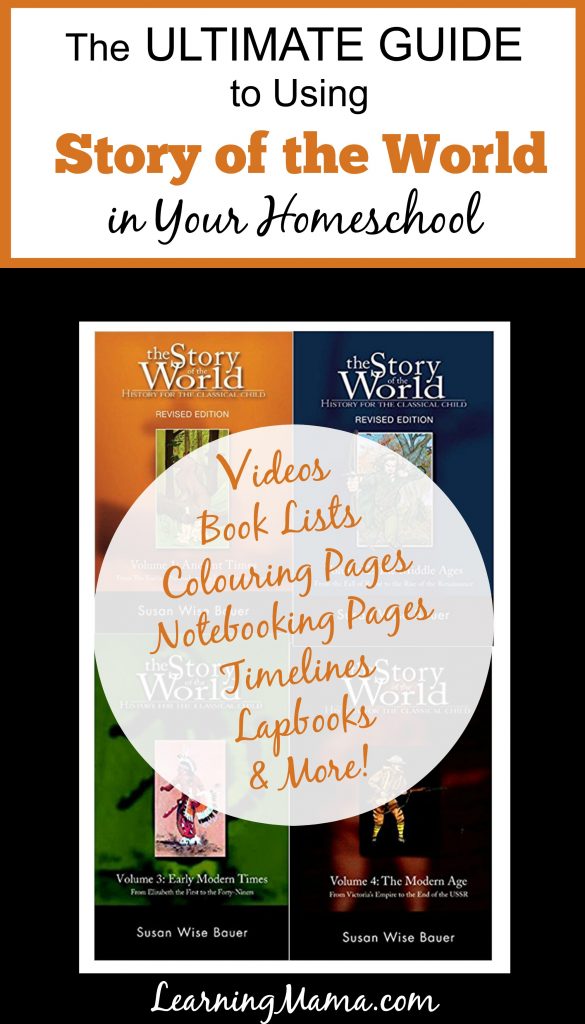
This post contains affiliate links. Please see my disclosure policy for details.
I’ve been talking a lot lately with friends who use Story of the World in their homeschool about how we use it in our homeschool and what other resources are available to complement it. We’re nearing the end of the program, and I love sharing with those who are just starting out!
There are a LOT of options — everything from simply reading the book and talking about it with your children to doing numerous activities and unit studies for each chapter. There’s supplemental reading, timelines, lapbooks, notebooking, videos, audiobooks, crafts … the possibilities are endless.
The core of the curriculum is, of course, the Story of the World books themselves. Well Trained Mind Press also offers audio CDs, Activity Guides, Student Pages, and tests to accompany each of the four volumes. We’ve never done the tests, and I’ve always just used the student pages included in the Activity Guides but you can certainly make your life easier by buying them pre-printed or printing from the pdf download. I HIGHLY recommend the audio versions by Jim Weiss!
RELATED: How to Use Story of the World with Multiple Ages
No matter how you chose to use The Story of the World in your homeschool, you’ll probably find something in this post that will help you enjoy this wonderful history curriculum in your own homeschool.
Supplemental Reading for Story of the World
The Additional History Reading and Corresponding Literature Suggestions provided in the activity books are a great resource for supplemental reading. If you’re working with a variety of ages and not necessarily the target ages of each of the volumes though, you might have a little bit of digging to do to find appropriate materials for your children. Here are some excellent booklists to get you started:
Book Lists for Volume 1:
- Story of the World Volume 1 Reading List from Sparrows at Home
- Ancient History Cycle Elementary Book List from Misty at Simply Convivial
- 10 Living Books for Teaching Ancient History from Cindy at Our Journey Westward
- Ancient Civilization Living Books from Tina at Tina’s Dynamic Homeschool Plus
- Story of the World Volume 1 Booklist from Irishmum (I love that this list is organized by chapter!)
- Story of the World + Magic Treehouse Reading Guide from Gale at Imaginative Homeschool (Volumes 1 & 2 available)
Book Lists for Volume 2:
- A Medieval Booklist from Jennifer at Grammarlings
- Medieval History Cycle Book List from Misty at Simply Convivial
- 10 Living Books to Teach Medieval History from Cindy at Our Journey Westward
- Story of the World Volume 2: The Middle Ages Book List from Irishmum (I love that this list is organized by chapter!)
- Story of the World + Magic Treehouse Reading Guide from Gale at Imaginative Homeschool (Volumes 1 & 2 available)
Book Lists for Volumes 3 & 4:
I’ve grouped these together as many book lists don’t distinguish between Early Modern and Modern History.
- Modern History Cycle Book List from Misty at Simply Convivial
- Literature List for Story of the World Volume 3 from Lexi at Lextin Eclectic
- 10 Living Books to Teach Early American History from Cindy at Our Journey Westward
- 10 Living Books to Teach Modern American History from Cindy at Our Journey Westward
- Story of the World Volume 4 Chapter books from Lexi at Lextin Eclectic
- Story of the World Volume 4 Picture Books from Lexi at Lextin Eclectic
- Modern History Book List from Michelle at Homeschooling Downunder
- World War II Books for Children from Storyformed
Story of the World Lapbooks
The Volume 1 Lapbook listed below was hosted on a blog that is no longer available, but the dropbox file is still there and can be accessed. Another blogger, Carrot Top x 3 has created lapbooks for the last three volumes. Perfect for kids who love to cut & paste!
Story of the World Notebooking Pages
We started our history notebooks 4 years ago using simple, lined paper. Lined paper does work, but using pre-made notebooking pages makes notebooks look so much better! NotebookingPages.com offers a huge selection of History Notebooking Pages (and timelines) that you can purchase in individual bundles, and a membership to their site gets you lifetime access to ALL their notebooking pages.
I’ve also created my own notebooking pages specifically for use with Story of the World, complete with the particular chapter titles and sub-headings.
- Story of the World Volume 1 Notebooking Pages
- Story of the World Volume 2 Notebooking Pages
- Story of the World Volume 3 Notebooking Pages
- Story of the World Volume 4 Notebooking Page
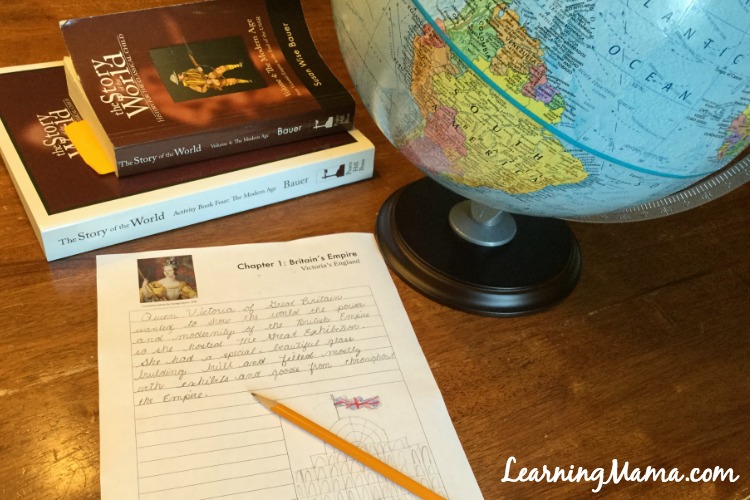
Timelines
Timelines are a great way to help your students see how events in history overlap and relate to one another. Sometimes our children can compartmentalize historical events, and the visual representation that a timeline provides can help them to understand that history is unfolding simultaneously all over the world. What was going on in Africa during the American Revolution?
There are several types of timelines and you can use any of them with Story of the World; chose the one that best meets your needs and preferences:
Wall timeline
A timeline that you attach to the wall is a great visual way of displaying history if you have the space (or the inclination for this type of home decor).
- Here’s a very detailed post about how to make a wall timeline.
- Make a wall timeline using clothespins and cards (see Timelines & Cards listed below).
Book of Centuries
Another great option is to create a timeline in a notebook or binder.
- FREE Printable Timeline Notebook Pages (lined and unlined) from Judy at Contented at Home
- History Timeline Notebooking System from NotebookingPages.com. For a modest cost, you can use their templates for making your own history notebook, including notebooking pages, title pages, timeline pages, cover pages & more. Access to this is free if you have a Lifetime Membership.
- FREE Expandable Book of Centuries from Amy at Living and Learning at Home.
- Simply Charlotte Mason also has a downloadable Basic Book of Centuries available for free.
- Contented at Home has FREE Printable Timeline Notebook Pages with both lined and unlined options.
Foldable/Accordion Timeline
This is the best of both worlds in my view –you get the flow of a wall chart with the compactness of a notebook. Pages are attached so you get the whole flow of history but fold into a book to save space. Any of the Book of Century options listed above will work, and this link to Notebooking Pages also has a video of how to assemble one.
Pre-made Timeline
You don’t have to make your own timeline, there are a lot of timelines available for purchase. There wall timelines, book of centuries, and notebooks available. We have the Adams Synchronological Chart or Map of History which folds out of a (very large!) book and it is pretty.
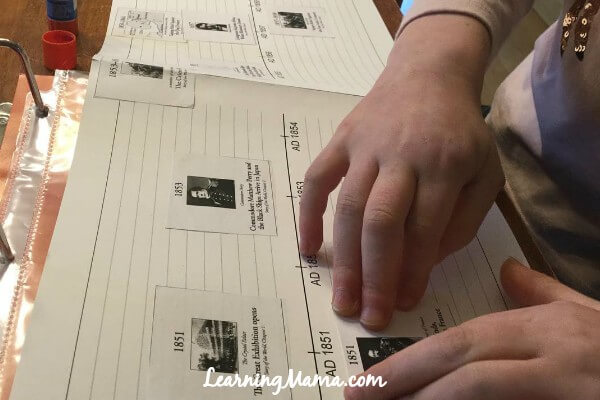
Timeline Figures/Cards
Once upon a time, a blogger actually created all the timeline figures needed for Story of the World and made them available for free on her blog. Unfortunately, those files are no longer available. I did find timeline cards for Volume 1, but you’re going to need an alternative plan for the other three volumes. The good news is that it’s easy enough to make your own timeline figures. If you want to do-it-yourself — have your children draw their own, or search online for images of the main players in each chapter. There are also some pre-made options available though they aren’t organized especially for SOTW. Here’s a few to get you started:
- Ancient History Timeline Figures Using Classic Art
- Ancient History Timeline Figures — this one was designed to use with Mystery of History
- Medieval History Timeline Figures — this one was designed to be used with Mystery of History
- Famous Kings and Queens of England
- History Through the Ages — Homeschool in the Woods’ timeline figures are not free (well, sometimes they are!) but they are affordable in downloadable format and are very well done.
Colouring Pages
Something we have really enjoyed with our Story of the World lessons has been using complementary colouring pages. Colouring is a great way to keep busy kids quiet while you read aloud from The Story of the World books or from your supplemental reading choices.
While the activity guides do contain some colouring pages, we have also purchased some history-themed colouring books. Bellerophon and Dover have lovely history-themed colouring books at great prices!
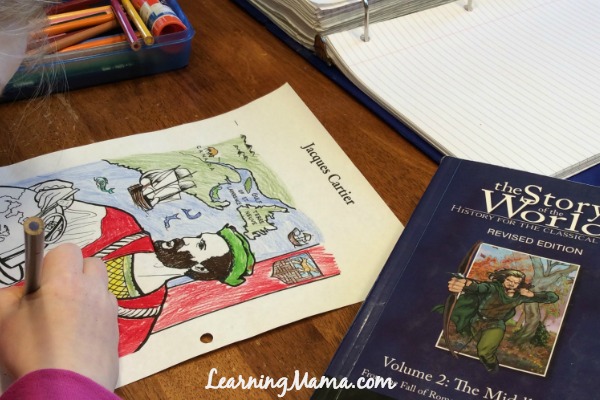
I also recently made the discovery that Well Trained Mind Press has also produced some supplemental downloadable colouring pages to go along with SOTW Volume 4 featuring a colouring page for each chapter. My kids were super excited about this as the activity guide for volume 4 contains significantly less colouring pages than previous volumes.
There are also many historically themed colouring pages available for free online that are worth looking into:
- Egyptian God & Goddesses Colouring Pages
- FREE Greek Mythology Colouring Pages
- FREE Viking Colouring Pages
- World Landmarks Colouring Pages: Included are the pyramids, Colosseum, Taj Mahal, and more!
- FREE Civilizations Colouring Pages: Ancient Greece & Egypt, Native Americas, Lewis & Clark, and more!
- FREE Castles Colouring Book: 21 Actual European castles to colour!
- FREE Printable Samurai Cut & Paste
- Printable Historical Paper Dolls: Medieval, Ancient, Elizabethan, and more!
- Printable Colour the World colouring pages
- History Colouring Pages featuring various historically themed pages from ancient Egypt, American history, and even a WW2 evacuation colouring page!
- FREE Dover History Sample Colouring Pages arranged by time period
History Videos
- Brookdale House’s Free History Videos for Kids: these are arranged chronologically, and there are videos for ancient, medieval, early modern and modern history. We’ve enjoyed many of these videos over the years!
- Story of the World Volume 4 Video Playlist: A complete playlist of videos for Volume 4, arranged by chapter and subchapter headings.
- Ancient History with PBS: A list of 60 PBS documentaries (with chapter notation for SOTW) to watch when studying ancient history.
Audio Books & Dramas
The audio versions of all four Story of the World volumes have been wonderfully narrated by the talented Jim Weiss and are available on CD or mp3 download. But did you know that Jim Weiss has also narrated numerous other audiobooks and dramas that make great additions to your history studies? Jim Weiss’ audiobooks are available from Well Trained Mind Press, Amazon, and probably even your public library.
The Story of the World Activity Guides also provides extensive lists of both history and literature book lists to complement each chapter. It is definitely worth checking to see if you can access the audio versions of some of these books! I’ve found many of them available on Audible.
History-Themed Art Lessons
A fun idea to supplement your Story of the World experience is to incorporate history-themed art lessons into your history studies. A great way to spruce up your history notebooks!
Ancient History Inspired Art Lessons
- Creation Chalk Pastel Video Art Lesson (free sample lesson from ChalkPastel’s Old Testament Bible Stories Video Art Lessons)
- Coliseum Chalk Pastel Video Art Lesson (free sample lesson from ChalkPastel’s Ancient History Video Art Lessons)
- How to Draw a Roman Soldier
- Easter Crown of Thorns Art Lesson
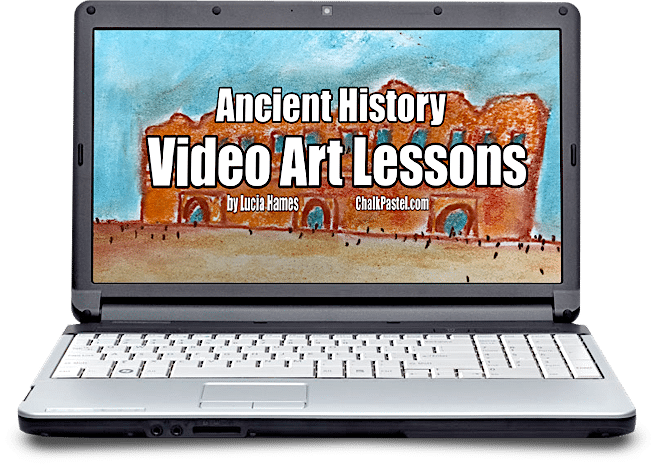 Medieval/Middle Ages Inspired Art Lessons
Medieval/Middle Ages Inspired Art Lessons
- How to Draw a Viking
- How to Draw a Knight
- Chalk Pastel Shield (free sample lesson from ChalkPastel’s Knights and Crusaders Video Art Lessons)
- Chalk Pastel Crown (free sample lesson from ChalkPastel’s Middle Ages Video Art Lessons)
- Medieval Castle Chalk Pastel Tutorial
- Medieval Castle and Crown Chalk Pastel
- Columbus Sailed the Ocean Blue Chalk Art Tutorial
Early Modern/Modern History Inspired Art Lessons
- How to Draw George Washington
- How to Draw Abraham Lincoln
- How to Draw a Realistic Tank
- How to Draw a Soldier
- Chalk Pastel George Washington (free sample lesson from ChalkPastel’s American History Art Lesson Bundle)
- Civil War Cannon Chalk Art Tutorial
Music Appreciation Through Historical Periods
We’ve really enjoyed using SQUILT Musical Eras to study music appreciation along with our current historical period. With four volumes (Baroque, Classical, Romantic, and Modern) they’ve got everything but ancients covered!
really enjoyed using SQUILT Musical Eras to study music appreciation along with our current historical period. With four volumes (Baroque, Classical, Romantic, and Modern) they’ve got everything but ancients covered!
What are your favourite resources for using with The Story of the World? Did I miss any?

See more of my Ultimate Guides Here:
 The Ultimate Guide to Homeschool Podcasts
The Ultimate Guide to Homeschool Podcasts

The Ultimate Guide to Keeping Busy Kids Quiet (& Engaged!) During Read Alouds
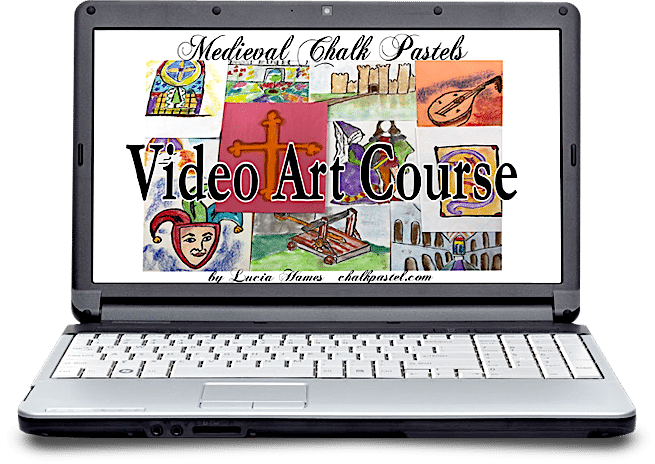
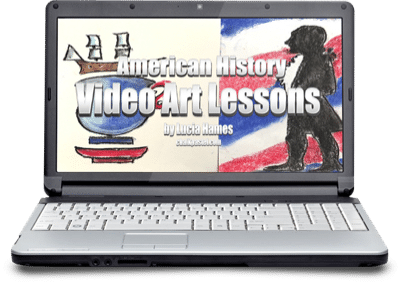


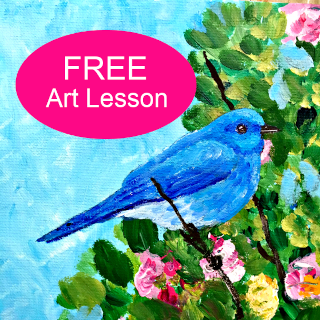
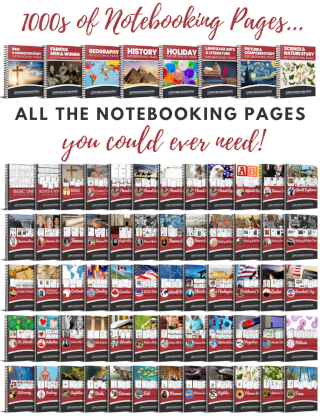
we simply read through the chapters, found them fascinating. 🙂
They are fascinating for sure! I’ve learned more history in the last 4 years reading these books, than in the whole rest of my life combined!
Would this be appropriate for 8yr old going on 9?
Yes, definitely! I’m currently doing SOTW 4 with my almost 10 & almost 7-year olds.
SOTW 1 is targeted for grades 1-4
SOTW 2 is targeted for grades 2-5
SOTW 3 is targeted for grades 3-6
SOTW 4 is targeted for grades 4-7
I’m not the blogger…but Nicky, yes, this would absolutely be appropriate for an 8 yr old, going on 9. I started with my son at 6 at a VERY slow pace (doing a lot to break up the material to make it a little easier for his short attention span, and adding visuals when I could). He’s 9 now and he LOVES this. I still add visuals and such but don’t have to break up the material into smaller parts (we do one section of a chapter each day…there are usually 1-3 sections in each chapter). So starting at 8 I think would be perfect!
Thanks for chiming in Gale!
This is excellent! Thanks for putting together all this info!
Thank you, and you’re welcome!
This is amazing! Thank you! Do people ever share their OneNote SOTW lesson plans?
Hi Keri,
I don’t know anything about OneNote, but I have seen lesson plans shared online in Facebook groups.
You might wish to try:
Well Trained Mind Facebook Group
The Well Trained Mind for the Grammar Stage Facebook Group
Story of the World History Group
Story of the World Volume 1 Facebook Group
Story of the World Volume 2 Facebook Group
Story of the World Volume 3 Facebook Group (this one seems pretty much inactive though)
Story of the World Volume 4 Facebook Group
We are going to start Story of the World in the fall with my first grader. Can I say THANK YOU!! This truly is the Ultimate Guide! I googled whether or not the student pages and tests were really necessary and ended up finding this gem of an article! So thankful!
This is really a terrific group of resources all in one place! The one thing I’m trying to figure out as I look at this curriculum is what do I actually do in a day? We are currently doing history daily with small readings (2 pages average), a weekly activity and a timeline with pictures to color and put up. When I look at a “chapter”, is that intended to be a week? Is there a break down of daily schedule somewhere? I don’t plan to use the tests, just the text and activity book. Thank you for any guidance you can provide.
Hi Karie,
There are probably as many ways to use SOTW as there are families who use it 🙂
This is what we do:
We do History twice a week, typically covering one chapter. Most chapters are broken into two sub-headings, and we do one for each lesson. I read from the book while my kids colour. Sometimes I ask the comprehension questions, sometimes not. Then, my second grader narrates to me while I write it down for her. My fifth grader writes her own narration. Then we do the map work. I put all the supplemental reading books on hold at the library a few weeks in advance and I put them into our history basket for free reading. I like to grab read alouds from these selections sometimes too.
Sometimes we watch videos that go along with each chapter.
We rarely do activities.
Every couple of weeks or so, my fifth grader works on her timeline (we’re using the figures from the activity guide).
I hope this helps!
I will be homeschooling my daughter who will be going into 3rd grade this coming school year. She’s never been introduced to Story of the World, or any real history lessons. Would it be best to start her with book 1?
I’m a fan of studying history chronologically, so I would definitely say start with Volume 1: Ancient Times. Not that it would be terrible to start with whatever historical period you are most interested in though. Enjoy!
Thank you! I’d prefer to start with book 1, rather than 3 😉
Love this series! Comprehensive and interesting! Made it so easy to cover history with multi grade children at the same time.
Has anyone complied a list of historical events that we should cover from the end of vol 4 to present?Was going to work on that today since I just finished the 4th book but wanted to see if there was a list available.
I’m not aware of any, but it sounds like a good project!
I am looking for the audio mp3 download of all 4 volumes. Is there a place to get them all? I don’t want to order cd’s because they get wrecked too easily and I don’t love paying for shipping 🙂 Thanks!
Hi Anita,
The mp3 downloads are available from the Well Trained Mind’s website: https://welltrainedmind.com/p/the-story-of-the-world-series-audiobook-combo-mp3/
Thank you!!!
Since I have 6 children covering 8 school grades we have worked through all 4 volumes of SotW at least 3 times now. As an adult I have learned so much that I figured my kids could benefit from the repetition. I’ve looked at many programs over the years (and having been homeschooled myself I have a lot of material to work with) and hands down this works best for our family.
Yes, it’s working great for us too! Love it.
These are great resources, thank you! Do you have note booking pages for SOTW volume 1 by chance?
Hi Amy,
I do, but they’re not done yet! It will likely be a few months until they are done and up on the blog.
How does this series cover slavery? Thanks
Slavery is covered in Volume 3 & 4. There is also mention of slaves in ancient Greece in Volume 1 I believe.
I love SOTW also, however I am always frustrated by the fact there are 42 chapters and we do a 36 week school year. I know, I know…I can just cut out some chapters or double up on others, but I feel like the material is so excellent I hate to do that. Also, I always feel like I’m missing something important, or guilty if we don’t complete them all. Does anyone else have this issue? What have you done about it? Are there certain chapters (esp for Vol 3) that you found were redundant and more easily skipped?
Some people double up or cut out, but I don’t. I just don’t expect to start and finish each volume at the start & end of each school year. Each volume takes us over a year to complete, but that’s ok with me.
We began Volume 1 in second grade and hope to finish it up by the end of first term, grade 3. I had wanted to finish a volume per school year and planned on covering the remaining chapters during the summer, but we needed a break! There is already so much information to digest in each chapter, when (many) additional library readings are included, that rushing to complete over 1 chapter/week would result in less retention of information. I was encouraged to find out that other families begin the series later and take longer to finish! So much for 3 cycles in 12 years!
Thank you for all of your work and your willingness to share. This has been a huge help for me! I’m wondering what you use to teach the period of time since the end of the USSR (after SOTW 4). As hard as it is for me to believe, there is already a lot of “history” that has happened since then – and it is definitely history to my kids.
That’s a great question, Diane. We’re not quite down Volume 4 yet, so I haven’t really put a lot of thought into it.
What a fantastic write-up for SOTW! So many great resource ideas.
Hello, I am brand new to homeschooling and will start homeschooling my sixth grade daughter in the fall, as we decided to do that for middle school and high school. I’ve decided that I would like to do Story of the world. Where should I start? Is volume 1 appropriate for her age? She’s 11 and will be in sixth grade. And what volume for seventh grade? Eighth grade? Thanks!
Hi Cordia!
While SOTW 1 is geared for students in approx grades 1-4, I do think you could still use it with a 6th grader as long as you assign supplemental reading and assignments. Well Trained Mind’s online academy uses Volume 1 at that age, you can take a peek at their course description and syllabus here: https://www.wtmacademy.com/courses/classes/story-of-ancient-times/
It’s always my preference to start at the beginning 🙂
Another option you might like is to read through Volume 1 together now or this summer and jump into Volume 2 in the fall — then she will have completed a full history cycle before entering the high school years.
I hope that helps! I’m excited for you as you begin homeschooling — SOTW has been our very favourite resource over the years and I hope you love it!
I can’t find the SOTW video links… it says the blog is no longer there… I am freaking out!!!
Any idea why??
Thanks Cassidy
It looks like the blog has been taken down, unfortunately.
Thank you so very much!!!
I am doing SOTW this year and this is perfect! I am really excited about the video links! But when I clicked on it, it says that it has been removed! Do you have the new link to them?
Hi Joann,
It looks like the blog has been taken down by the content owner. Sometimes it’s only temporary, so check back in a month or so. Unfortunately, I don’t think this resource has been provided elsewhere.
We provide Timeline Posters and Cards which are easy to print and use. The cards are sorted chapter-by-chapter from popular living history books. We also have Timeline Cards based on The Story of the World series.
http://www.livingbooktimelines.com
Thanks for sharing!
I would like to get the books as a gift for my cousin who is 10 years old. She is an advanced and avid reader and loves history. Should I get her all 4 volumes? Or jus the 3rd or 4th one would be OK? Does this go in chronological order?
The Story of the World books are chronological, starting with ancient history in volume one and finishing up with modern in volume 4. If she has a particular time period she is interested in, you could get that. I do think the volumes would stand alone but we love the whole series.
Thank you so much for the notebooking pages. They are really great and we are looking forward to using them with Volume 1. It still says Volume 2 says “coming soon.” Do you know when they will be available? Thank you again.
Volume 2 is available! I’ve updated the post with the link.
Just letting you know, the Grammarlings Medieval booklist seems to have been taken down.
Thanks again for keeping up this great list!